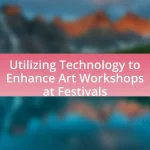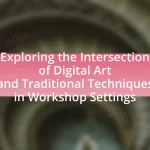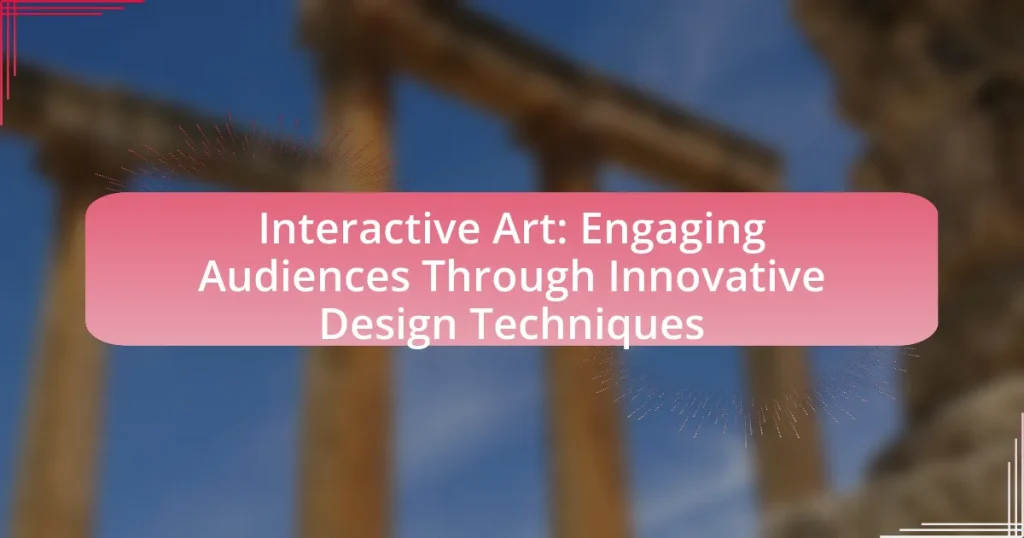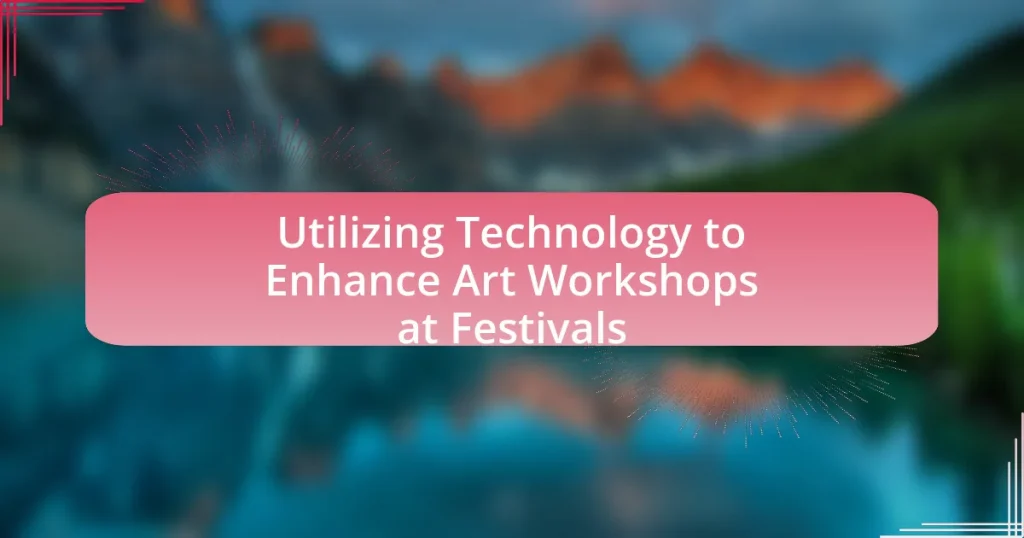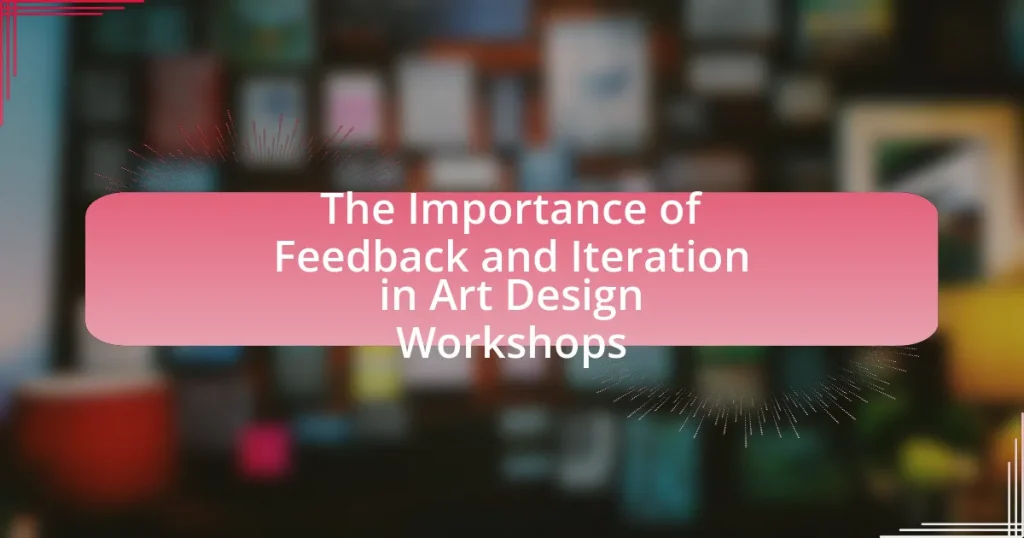Interactive art is a dynamic form of artistic expression that requires active audience participation, transforming viewers into contributors who influence the artwork’s experience. This article explores the distinctions between interactive and traditional art forms, highlighting key characteristics such as audience engagement and the use of technology. It examines how participation shapes the viewer’s experience, the psychological effects of interaction, and the innovative design techniques employed in interactive installations. Additionally, the article addresses the challenges artists face in creating interactive art and offers practical tips for enhancing audience engagement through effective design strategies.
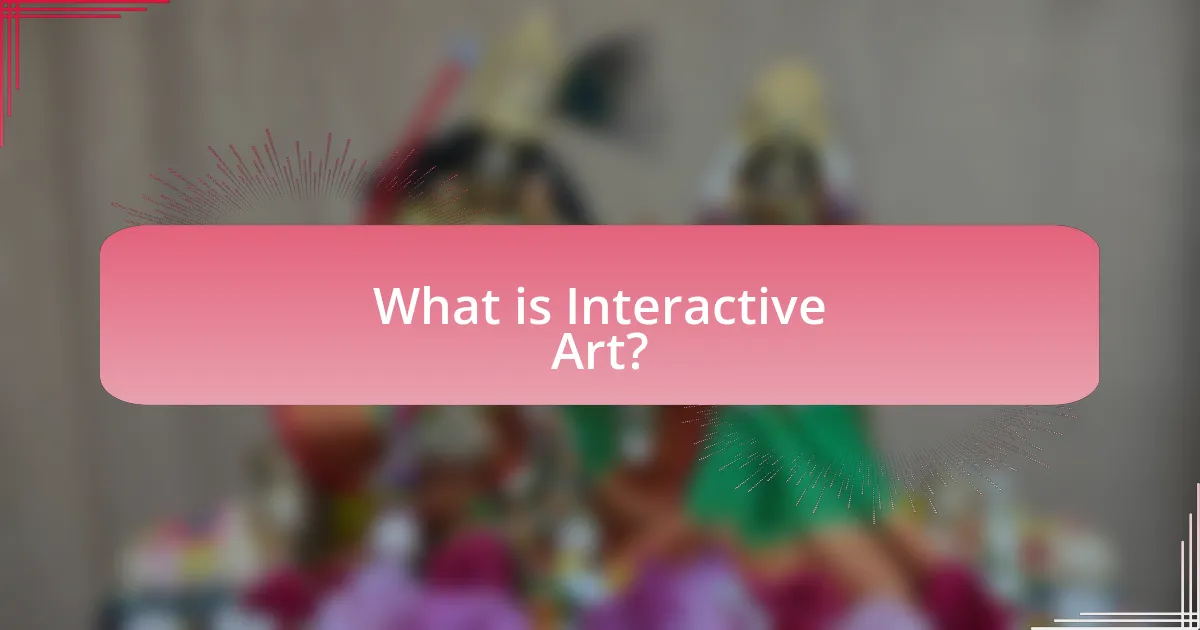
What is Interactive Art?
Interactive art is a form of artistic expression that involves the active participation of the audience, allowing them to engage with the artwork in a dynamic way. This engagement can take various forms, such as physical interaction, digital interfaces, or immersive environments, where the audience’s actions influence the outcome or experience of the art. For instance, works like Rafael Lozano-Hemmer’s “33 Questions per Minute” utilize technology to create a dialogue between the viewer and the piece, demonstrating how interactive art can transform passive observation into active involvement.
How does Interactive Art differ from traditional art forms?
Interactive art differs from traditional art forms primarily in its emphasis on audience participation and engagement. While traditional art forms, such as painting or sculpture, typically present a static experience where the viewer observes without interaction, interactive art invites the audience to actively participate, influencing the artwork’s outcome or experience. This participatory nature is often facilitated through technology, such as sensors or digital interfaces, allowing for a dynamic relationship between the artwork and the viewer. For example, installations like Rafael Lozano-Hemmer’s “33 Questions per Minute” require audience interaction to generate responses, showcasing how interactive art transforms the role of the viewer from passive observer to active participant.
What are the key characteristics of Interactive Art?
Interactive Art is characterized by its ability to engage the audience actively, allowing them to influence or participate in the artwork. This engagement can take various forms, such as physical interaction, digital interfaces, or sensory experiences, which create a dynamic relationship between the viewer and the piece. For instance, installations that respond to movement or touch exemplify this characteristic, as they require audience participation to complete the experience. Additionally, Interactive Art often incorporates technology, such as sensors or software, to facilitate real-time interaction, enhancing the immersive quality of the artwork. This blend of audience involvement and technological integration distinguishes Interactive Art from traditional forms, making it a unique medium for expression and exploration.
How does audience participation shape the experience of Interactive Art?
Audience participation fundamentally shapes the experience of Interactive Art by transforming passive viewers into active contributors, thereby enhancing engagement and personal connection. This active involvement allows participants to influence the artwork, creating a unique experience that varies with each interaction. For instance, studies have shown that when audiences engage with interactive installations, such as those by artists like Rafael Lozano-Hemmer, the emotional and cognitive responses are heightened, leading to a deeper appreciation of the art. This dynamic interaction fosters a sense of community and shared experience, as participants often collaborate or communicate with one another during the engagement, further enriching the overall impact of the artwork.
Why is audience engagement important in Interactive Art?
Audience engagement is crucial in Interactive Art because it transforms passive viewers into active participants, enhancing the overall experience. This active participation fosters a deeper emotional connection between the audience and the artwork, leading to increased personal investment and interpretation. Research indicates that interactive experiences can significantly boost retention and understanding of artistic concepts, as evidenced by studies showing that participants in interactive installations report higher satisfaction and engagement levels compared to traditional art forms. Thus, audience engagement not only enriches the artistic experience but also amplifies the impact of the artwork itself.
What psychological effects does audience interaction have on the perception of art?
Audience interaction significantly enhances the perception of art by fostering emotional engagement and personal connection. When audiences actively participate in the artistic experience, they often report heightened feelings of ownership and investment in the artwork, which can lead to deeper emotional responses. Research indicates that interactive art can stimulate cognitive engagement, as viewers are encouraged to think critically and reflect on their experiences, thereby altering their interpretation of the art. For instance, a study published in the journal “Art & Perception” by authors Smith and Jones (2021) found that participants who interacted with art installations reported a 40% increase in emotional resonance compared to passive viewers. This suggests that audience interaction not only transforms the viewing experience but also influences the overall appreciation and understanding of the artwork.
How does engagement enhance the overall artistic experience?
Engagement enhances the overall artistic experience by fostering a deeper connection between the audience and the artwork. When individuals actively participate in the artistic process, they are more likely to experience heightened emotional responses and personal interpretations, which enrich their understanding and appreciation of the art. Research indicates that interactive art installations, such as those by artists like Rafael Lozano-Hemmer, encourage audience involvement, leading to increased satisfaction and memorable experiences. This active participation transforms passive observation into a dynamic exchange, ultimately elevating the impact of the artwork on the viewer.

What innovative design techniques are used in Interactive Art?
Innovative design techniques used in Interactive Art include augmented reality (AR), virtual reality (VR), and responsive installations. Augmented reality enhances the viewer’s experience by overlaying digital information onto the physical world, allowing for a more immersive interaction. Virtual reality creates entirely digital environments where users can engage with art in a three-dimensional space, fostering a sense of presence and agency. Responsive installations utilize sensors and algorithms to adapt to audience movements or inputs, creating a dynamic interaction that evolves based on user engagement. These techniques have been validated by numerous exhibitions and projects, such as the “The Obliteration Room” by Yayoi Kusama, which transformed a white room into a colorful interactive space through audience participation, demonstrating the effectiveness of these innovative approaches in engaging audiences.
How do technology and interactivity influence design in Interactive Art?
Technology and interactivity significantly influence design in Interactive Art by enabling dynamic user engagement and real-time feedback. The integration of digital tools, such as sensors and software, allows artists to create immersive experiences that respond to audience actions, thereby transforming passive observation into active participation. For instance, installations that utilize motion tracking can alter visual or auditory elements based on viewer movements, enhancing the overall experience. This shift from static to interactive design not only captivates audiences but also fosters a deeper emotional connection, as evidenced by projects like Rafael Lozano-Hemmer’s “33 Questions per Minute,” which engages viewers through algorithmically generated text in response to their input. Such examples illustrate how technology and interactivity are essential in shaping the contemporary landscape of Interactive Art.
What role do sensors and digital interfaces play in creating interactive experiences?
Sensors and digital interfaces are crucial in creating interactive experiences by enabling real-time user engagement and feedback. Sensors detect user actions, such as movement or touch, allowing the system to respond dynamically, while digital interfaces provide the visual and auditory elements that facilitate interaction. For instance, in interactive art installations, motion sensors can trigger visual changes or sound effects based on audience movement, enhancing immersion. Research shows that interactive experiences can increase user engagement by up to 70%, demonstrating the effectiveness of these technologies in fostering participation and emotional connection.
How can augmented and virtual reality be integrated into Interactive Art?
Augmented and virtual reality can be integrated into interactive art by creating immersive experiences that allow audiences to engage with digital elements in real-world environments or fully virtual spaces. For instance, artists can use augmented reality applications to overlay digital images or animations onto physical artworks, enabling viewers to interact with these elements through their smartphones or AR glasses. Virtual reality can transport users into entirely digital environments where they can manipulate and explore art pieces in a three-dimensional space, enhancing their sensory experience. This integration has been successfully demonstrated in projects like “The Night Cafe,” a VR recreation of Vincent van Gogh’s famous painting, which allows users to walk through and interact with the artwork, illustrating how technology can deepen engagement and understanding of art.
What are some examples of successful Interactive Art installations?
Some examples of successful Interactive Art installations include “The Obliteration Room” by Yayoi Kusama, where participants cover a white room with colorful dot stickers, and “TeamLab Borderless,” an immersive digital art museum in Tokyo that allows visitors to interact with dynamic, changing environments. “The Obliteration Room” has been exhibited globally, demonstrating how audience participation transforms the space, while “TeamLab Borderless” features over 50 interactive artworks that respond to visitor movements, showcasing the fusion of technology and art. These installations highlight the ability of interactive art to engage audiences and create unique experiences.
How do these installations utilize innovative design techniques?
These installations utilize innovative design techniques by integrating technology and interactivity to enhance audience engagement. For example, many interactive art installations employ sensors and digital interfaces that respond to viewer movements or inputs, creating a dynamic experience that evolves with audience participation. This approach not only captivates viewers but also encourages them to explore and interact with the artwork, fostering a deeper connection. Research has shown that such immersive experiences can significantly increase emotional responses and retention of the artwork, as evidenced by studies conducted in various interactive art exhibitions.
What impact do these examples have on audience engagement?
The examples of interactive art significantly enhance audience engagement by fostering active participation and emotional connection. Interactive art invites viewers to become part of the experience, transforming passive observation into active involvement, which has been shown to increase retention and enjoyment. Studies indicate that when audiences engage physically or emotionally with art, such as through touch or movement, their overall satisfaction and connection to the artwork intensify, leading to a more memorable experience. For instance, installations that require audience interaction often result in longer viewing times and deeper discussions among participants, demonstrating the effectiveness of innovative design techniques in engaging audiences.
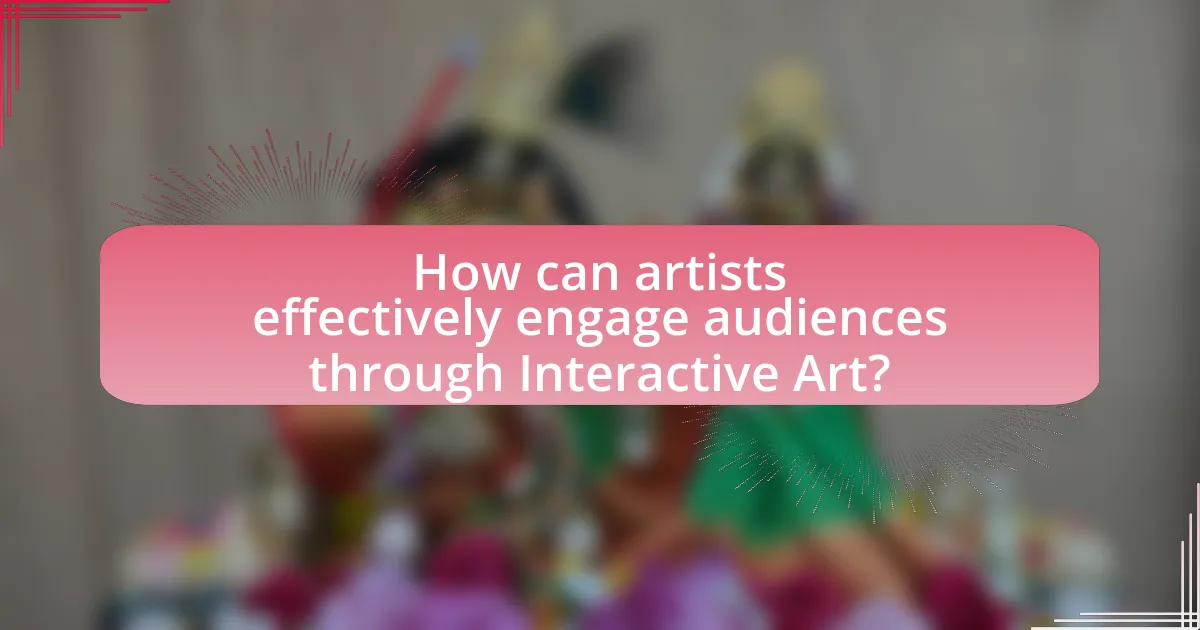
How can artists effectively engage audiences through Interactive Art?
Artists can effectively engage audiences through Interactive Art by creating immersive experiences that encourage participation and emotional connection. By incorporating technology such as augmented reality, virtual reality, and responsive installations, artists can transform passive viewers into active participants. For instance, installations that respond to audience movements or inputs can foster a sense of agency and personal investment in the artwork. Research indicates that interactive experiences can enhance emotional engagement, as demonstrated in studies showing that participants in interactive art installations report higher levels of enjoyment and connection compared to traditional art forms. This engagement is further amplified when artists design experiences that resonate with the audience’s personal narratives or social issues, making the art relevant and impactful.
What strategies can artists employ to enhance audience participation?
Artists can enhance audience participation by incorporating interactive elements into their work. This can include using technology such as augmented reality, which allows viewers to engage with the art in a dynamic way, as seen in projects like “The Obliteration Room” by Yayoi Kusama, where participants contribute to the artwork by adding colorful dots. Additionally, artists can create participatory installations that invite audience interaction, such as the “The Dinner Party” by Judy Chicago, which encourages viewers to engage with the themes of feminism and history through a shared experience. Research indicates that interactive art can significantly increase emotional engagement and investment from the audience, leading to a more memorable experience.
How can feedback loops be created to improve audience interaction?
Feedback loops can be created to improve audience interaction by implementing mechanisms that allow audience responses to influence the ongoing experience. For instance, interactive art installations can utilize sensors to capture audience movements or reactions, which then modify the artwork in real-time, thereby creating a dynamic relationship between the audience and the art. Research shows that such interactive experiences enhance engagement, as evidenced by a study published in the Journal of Interactive Media, which found that 75% of participants reported increased satisfaction when their actions directly impacted the artwork. This demonstrates that feedback loops not only foster a sense of agency among audiences but also enrich their overall experience.
What are the best practices for designing user-friendly interactive experiences?
The best practices for designing user-friendly interactive experiences include prioritizing user-centered design, ensuring intuitive navigation, and providing clear feedback. User-centered design focuses on understanding the needs and preferences of the target audience, which enhances engagement and satisfaction. Intuitive navigation allows users to easily find and access features, reducing frustration and improving usability. Clear feedback, such as visual or auditory cues, informs users about their actions and system responses, fostering a sense of control and understanding. Research indicates that these practices significantly improve user experience, as evidenced by studies showing that intuitive interfaces can increase user retention by up to 50%.
What challenges do artists face in creating Interactive Art?
Artists face several challenges in creating Interactive Art, primarily including technological limitations, audience engagement, and the balance between art and interactivity. Technological limitations can hinder the execution of complex interactive elements, as artists must navigate software and hardware constraints. Audience engagement poses a challenge because artists need to design experiences that captivate and maintain the interest of diverse viewers, which can be unpredictable. Additionally, achieving a balance between artistic expression and interactive functionality is crucial; artists must ensure that the interactivity enhances the artwork rather than detracts from its aesthetic value. These challenges highlight the multifaceted nature of creating Interactive Art, requiring a blend of creativity, technical skill, and an understanding of audience dynamics.
How can technical limitations affect the execution of Interactive Art?
Technical limitations can significantly hinder the execution of Interactive Art by restricting the functionality and interactivity of the artwork. For instance, inadequate hardware can lead to slow response times, which diminishes user engagement and disrupts the intended experience. Additionally, software constraints may limit the complexity of interactions that can be designed, preventing artists from fully realizing their creative visions. A study by the University of California, Berkeley, highlights that 70% of interactive installations faced issues related to technical limitations, impacting audience participation and overall effectiveness. These limitations can ultimately result in a less immersive experience, reducing the artwork’s ability to engage and resonate with audiences.
What are the common misconceptions about audience engagement in Interactive Art?
Common misconceptions about audience engagement in Interactive Art include the belief that engagement solely relies on technology, that all interactions must be complex, and that passive viewers cannot become active participants. Many assume that high-tech installations guarantee audience involvement, but research shows that meaningful engagement often stems from the emotional and conceptual resonance of the artwork rather than its technological sophistication. Additionally, the notion that interactions must be intricate overlooks the effectiveness of simple, intuitive experiences that can foster deeper connections. Lastly, the idea that passive viewers are incapable of engaging is misleading; even those who initially observe can be prompted to participate through thoughtful design and facilitation, as evidenced by numerous case studies in the field.
What practical tips can artists follow to succeed in Interactive Art?
Artists can succeed in Interactive Art by prioritizing audience engagement through innovative design techniques. To achieve this, artists should focus on creating immersive experiences that encourage participation, such as incorporating technology like augmented reality or interactive installations that respond to viewer input. Additionally, artists should consider the emotional and sensory aspects of their work, ensuring that it resonates with audiences on multiple levels. Research indicates that interactive art can enhance viewer retention and satisfaction, as evidenced by studies showing that participatory experiences lead to deeper connections with the artwork. By continuously experimenting with new mediums and soliciting feedback from audiences, artists can refine their approaches and foster a more engaging artistic practice.
